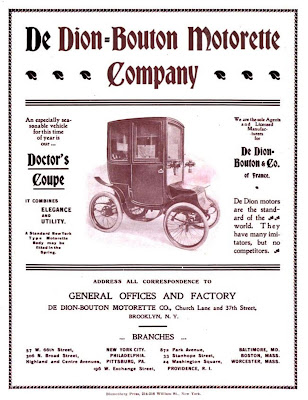 |
| My 1926 Doctors Coupe |
There's many a Model T Ford owner who will swear that the Doctors Coupe is a type of Model T, that it was a specific type of T made specially for physicians. There are just as many that will say that there’s no such thing as a Doctors Coupe and it's just a clever piece of marketing. On the Model T forums on the internet it’s one of those “hot button” topics along with “what motor oil should I use?” and “what’s the best material for transmission bands?”.
I have even seen one person state with the greatest authority that the term Doctors Coupe was coined by Cadillac in 1906, with their first enclosed car, the model M. At the end of this post I shall present evidence to the contrary.
What exactly is a coupe? The word coupé comes from the French verb to cut, “couper”. (KOO-PAY is the correct pronunciation. KOOP being an Americanization)
This new type of carriage appeared a the end of the 17th Century. It was created by cutting off the front of a Berlin or (Berline) coach, thus removing the rear facing seats. This created a small, lightweight private coach, suitable for when the women of the time wanted to go out shopping. It was known as the Berline-coupé. Which quickly was shortened to coupé.
Where Doctors came into it, I do not know. Doctors are recorded using coupes in the days of the horse drawn vehicle for the term to carry over. But there is as much evidence that doctors used horses and buggies as well. Reviewing an 1893 issue of "The Hub" magazine. A publication specifically for the coach building tradesman, has adverts suggesting that a Phaeton, a sporty lightweight carriage was a suitable conveyance for a physician.
 |
| "The Hub" in 1893 carried an advertisement for a Doctors Phaeton. |
 |
| Buggy, Brougham, or Coupe? In this court record a witness isn't sure. |
Many car manufacturers claim to have a Doctors Coupe in their range: Ford, Talbot, Oldsmobile, Cadillac, Hudson for starters. There was clearly a concerted effort among car manufacturers to get doctors to purchase one of their automobiles, and they probably thought that a small, lightweight vehicle such as a coupe would be suitable for their uses.
Doctors are respected members of the community and if one were to be seen in a particular vehicle. That could be good publicity for the marque. In fact, the publishers of The Horseless Age magazine printed a “Business Automobiles" special issue of their magazine in 1901 with extensive coverage of vehicles for Doctors.
 |
| An advertisement for a Business Automobiles special about vehicles for Doctors. |
There is also an article in "The Hospital" magazine an English publication from 1906, less detailed than the one in the Horseless Age, that treated the reader as someone who didn't know anything at all about the new method of transport called the automobile. In that piece, three vehicle styles were recommended as suitable for the profession; the Runabout, the Brougham, and the Landaulette. Amusingly, the article also recommends that the physician should consider a coachman/chauffeur, which is probably why the Brougham and Landaulette were recommended. Landaulette is a term that has passed into obscurity now, but in the early days of the automobile, it was a larger version of the Brougham where the passengers sat in a covered or convertible section and the driver sat in the open.
Then I came across something that really grabbed my attention. The story of the first physician in the USA to use a vehicle in his practice.
That was Doctor Carlos Booth, of Youngstown Ohio. In 1895 he designed his own vehicle, and had it made by the Freedonia Carriage and Manufacturing company of Youngstown, using a Pierce Crouch engine for power.
Dr. Booth called the vehicle "The Cab" though people who saw it called it the “Milk wagon”. Capable of a top speed of 18mph it could climb a 12% grade at 4mph. Impressed with his own creation he called it "the most serviceable motor wagon as has yet been produced." He even entered it in a motor race in New York, but it broke down half way around. Two photographs of the good doctors "cab" have come to light. One with an enclosed cab and the other open topped.
 |
| Doctor Booth's "cab" |
 |
| This second view of Doctor Booths Cab shows it in an open topped form. |
The first mention I have found for a Doctors Coupe is in this advert from The Horseless Age in January 1900 for a DeDion-Bouton. It looks like a Model Y DeDion. But in a previous magazine advert the vehicle was described a “Doctors Brougham”.
 |
| So far, the earliest reference I have found to the Doctors Coupe A DeDion-Bouton in "The Horseless Age" 1900. |
 |
| Yet a month earlier, the same vehicle was described as a Doctor's Brougham |
Were DeDion the first to coin the term in relation to the automobile? I have yet to find anything earlier, and I would welcome any documented proof of earlier automotive use of the term.
I don't think you will find that Ford ever officially referred to the coupe body style as a Doctor's Coupe,' although Ford did run ads promoting that body to doctors and similar professionals.
ReplyDeleteDodge, I believe it was, actually cataloged a Doctor's Coupe in the early '20s and denoted it as such on the car's data plate (I've seen pictures...). As far as I know, it was the only manufacturer who used the term as a published model name.
I once read the idea that the Doctors coupe was so called because the high roof meant one could wear ones top hat when driving :)
ReplyDelete